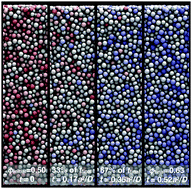“Dense diffusion” in colloidal glasses: short-ranged long-time self-diffusion as a mechanistic model for relaxation dynamics
Abstract
Despite decades of exploration of the colloidal glass transition, mechanistic explanation of glassy relaxation processes has remained murky. State-of-the-art theoretical models of the colloidal glass transition such as random first order transition theory, active barrier hopping theory, and non-equilibrium self-consistent generalized Langevin theory assert that relaxation reported at volume fractions above the ideal mode coupling theory prediction ϕg,MCT requires some sort of activated process, and that cooperative motion plays a central role. However, discrepancies between predicted and measured values of ϕg and ambiguity in the role of cooperative dynamics persist. Underlying both issues is the challenge of conducting deep concentration quenches without flow and the difficulty in accessing particle-scale dynamics. These two challenges have led to widespread use of fitting methods to identify divergence, but most a priori assume divergent behavior; and without access to detailed particle dynamics, it is challenging to produce evidence of collective dynamics. We address these limitations by conducting dynamic simulations accompanied by experiments to quench a colloidal liquid into the putative glass by triggering an increase in particle size, and thus volume fraction, at constant particle number density. Quenches are performed from the liquid to final volume fractions 0.56 ≤ ϕ ≤ 0.63. The glass is allowed to age for long times, and relaxation dynamics are monitored throughout the simulation. Overall, correlated motion acts to release dynamics from the glassy plateau – but only over length scales much smaller than a particle size – allowing self-diffusion to re-emerge; self-diffusion then relaxes the glass into an intransient diffusive state, which persists for ϕ < 0.60. We observe similar relaxation dynamics up to ϕ = 0.63 before achieving the intransient state. We find that this long-time self-diffusion is short-ranged: analysis of mean-square displacement reveals a glassy cage size a fraction of a particle size that shrinks with quench depth, i.e. increasing volume fraction. Thus the equivalence between cage size and particle size found in the liquid breaks down in the glass, which we confirm by examining the self-intermediate scattering function over a range of wave numbers. The colloidal glass transition can hence be viewed mechanistically as a shift in the long-time self-diffusion from long-ranged to short-ranged exploration of configurations. This shift takes place without diverging dynamics: there is a smooth transition as particle mobility decreases dramatically with concomitant emergence of a dense local configuration space that permits sampling of many configurations via local particle motion.



 Please wait while we load your content...
Please wait while we load your content...
